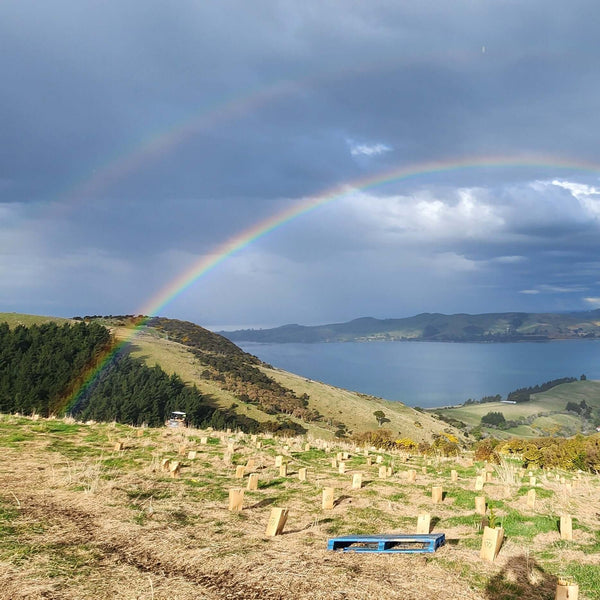Establishing A Diverse Forest To Return Existing Ecosystems On The South Island
Greenfleet’s Wenborn project kicked off in 2024 with the goal to restore the ecosystem that existed before the land was cleared. It is delivering climate action in coastal Dunedin by removing carbon.
"This project has allowed us to deliver climate action and expand our impact in New Zealand. Working closely with the Halo Project has meant we've had direct contact with the project throughout, trusting that the revegetation operations were in very good hands!" - Greenfleet's GM, Revegetation, Alex Paddock.
Situated in New Zealand’s South Island, the site is overlooking the picturesque Otago Harbour and will provide potential habitat for local birds and wildlife.

Location & Map
Located near Dunedin in New Zealand’s South Island, this area is known for its rich biodiversity and wildlife.
This is Greenfleet’s first project on the South Island and builds on the existing projects we have established in New Zealand. With over 550 forests growing across Australia and New Zealand, you can see where many of Greenfleet’s other revegetation projects are growing here.

Revegetation Approach & Species Selection
While delivering climate action, the goal of this project was to establish dense and diverse forest vegetation that reflects the ecosystem that existed before the land was cleared.
In total, Greenfleet planted 30 locally native, fast growing species that will thrive in the exposed conditions at Wenborn. The diverse species mix reflects the pre-clearing forest type and will stimulate natural recruitment and other ecological processes as the forest grows.
Approximately 20% of the species mix is made up by kanuka (Kunzea robusta), a locally native tree with stringy bark. It can grow up to 30 metres tall and will form an important part of the forest canopy. Other species planted include tōtara (Podocarpus tōtara) and toetoe (Austroderia richardii), a flowering perennial grass.
The property was divided into twelve different planting areas and the species divided based on different ecological values expected at each location. Greenfleet worked with the Halo Project to deliver the planting. The map here shows the completed planting area.

Wildlife Habitat Restoration
New Zealand is one of the most unique countries when it comes to wildlife. With a high level of endemism, most animals found here can’t be found anywhere else in the world. Within this, Dunedin is known as a wildlife hotspot in the South Island.
When Greenfleet restores a native forest, one of the first signs that the forest is establishing well is the return of native birdlife. Located in coastal Dunedin the forest growing at Wenborn will provide potential habitat for local bird species such as spotted shags, variable oystercatchers and spoonbills.
As the forest establishes, our ongoing monitoring will reveal the other local wildlife that will begin to call the forest home.
A post-planting photo at Wenborn, overlooking Otago Harbour. Photo credit: The Halo Project.
Climate Action
The forest growing at Wenborn is legally protected for 100 years. Over that time, it will remove around 5,400 tonnes of carbon from the atmosphere, which is equivalent to the emissions of 2,700 return flights between Melbourne and Dunedin.
Location Size
6 hectares in Coastal Dunedin, New Zealand.
Planting Dates
2024
Species
- Kānuka (Kunzea robusta)
- Kōhūhū (Pittosporum tenuifolium)
- Ribbonwood (Plagianthus regius)
- Kāpuka (Griselinia littoralis)
- Manuka (Leptospermum scoparium)
- Mingimingi (Coprosma propinqua)
- Lemonwood (Pittosporum eugenioides)
- Cabbage tree (Cordyline australis)
- Narrow-leaved lacebark (Hoheria angustifolia)
- Ngaio (Myoporum laetum)
- Mountain akeake (Olearia avicenniifolia)
- Kōwhai (Sophora microphylla)
- Koromiko (Hebe salicifolia)
- Teucridium (Teucrium parvifolium)
- Harakeke (Phormium tenax)
- Toetoe grass (Austroderia richardii)
- Mingimingi (Coprosma crassifolia)
- Putaputawētā (Carpodetus serratus)
- Horoeka (Pseudopanax crassifolius)
- Makomako (Aristotelia serrata)
- Fierce lancewood (Pseudopanax ferox)
- Red-currant coprosma (Coprosma rhamnoides)
- Mikimiki (Coprosma linariifolia)
- Red māpou (Myrsine australis)
- Three finger tree (Pseudopanax colensoi)
- Patete (Schefflera digitata)
- Kaikomako Shrub (Pennantia corymbose)
- Māhoe (Melicytus ramiflorus)
- Kōtukutuku (Fuchsia excorticata)
- Tōtara tree (Podocarpus tōtara)
- Kahikatea (Dacrycarpus dacrydioides)


